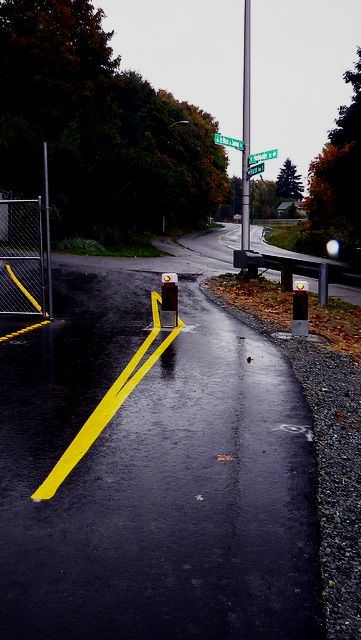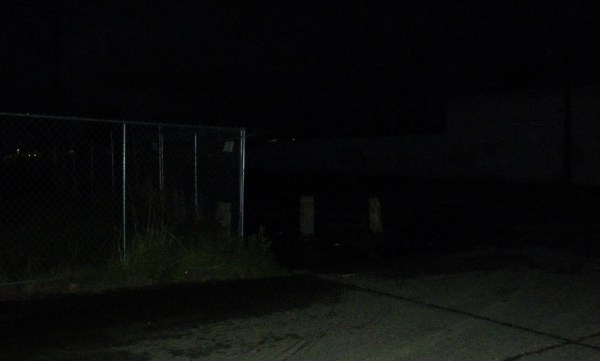
A bollard, for those who don't know the term, is one of those posts used to keep motor vehicles off of trails, sidewalks, and other non-motorized facilities. Many trail systems use them, but many use them badly, sometimes with tragic results. When a bicyclist moving at reasonable speeds runs into a bollard, common outcomes include serious injury, destruction of the bicycle frame, or even death.
If we were discussing a roadway, no competent traffic engineer
would consider placing unmarked telephone poles between the lanes
with no additional clearance or warnings. The results would be too
obvious. Yet some of these same engineers will suggest
placing bollards in the middle of bicycle trails with essentially no
warning for the bicyclists.
Here, for example, are three unpainted wooden bollards in a
90-degree turn. On a dry night like this, they show up just in
time to avoid hitting them. In rain, the wood is almost as dark
as the pavement.

This is not usually done with the intent of maiming bicyclists, even though that is the natural outcome. Instead, the people designing these bollards simply have not thought of them as obstructions in a roadway. Worse, sometimes the bollards are positively hidden, by designs intended to blend into a park-like setting, such as bollards made of unpainted wood, or of metal painted soothing dark blues or greens. For people who think of bicyclists as essentially rolling pedestrians, it's easy not to think of a bicycle as a vehicle moving 15-20 miles per hour, with the sight lines and clearances that demands.
It's up to cyclists to point out the error of these hazardous
installations if local authorities are in the rolling-pedestrian school.
It's easy for a lone cyclist to be dismissed as a whining malcontent, especially if the official in charge is predisposed to see cyclists that way. To avoid this, it helps to present the issue on the right terms, as a well-documented traffic safety concern.
First, let's look at two nationally-known design standards. While these do not have the force of law, they are authoritative references that are often incorporated into legal design standards.
The American Association of State Highway and Transportation Officials puts out many useful design references, including this one on bicycle facilities. Discussing access-control bollards, AASHTO says:
Shared use paths may need some form of physical barrier at highway intersections to prevent unauthorized motor vehicles from using the facilities. [....] Posts or bollards should be set back beyond the clear zone on the crossing highway or be of a breakaway design. The post should be permanently reflectorized for nighttime visibility and painted a bright color for improved daytime visibility. Striping an envelope around the post is recommended as shown in Figure 26. When more than one post is used, an odd number of posts at 1.5-m (5-foot) spacing is desirable. Wider spacing can allow entry to motor vehicles, while narrower spacing might prevent entry by adult tricycles, wheelchair users, and bicycles with trailers.
Figure 26, not reporoduced here, shows the bollard enclosed in 4-inch-wide yellow stripes, forming a diamond 2 feet wide by 3 feet long.
The Federal Highway Administration's Manual on Uniform Traffic Control Devices provides standardized signs, signals, and markings for all sorts of traffic situations, and this is no exception.
MUTCD Fig. 9C-2 illustrates the same pavement marking recommended in the AASHTO Guide, and Section 9C.03 specifies markings for "obstructions in the center of the path, including vertical elements intended to physically prevent unauthorized motor vehicles from entering the path." The MUTCD standard requires that: Obstructions in the traveled way of a shared-use path shall be marked with retroreflectorized material or appropriate object markers.
As used here, "object markers" are the familiar reflective signs used for roadside obstructions, such as yellow reflectorized diamonds or yellow-and-black diagonal lines.
In contrast to the hazardous bollards above, here's a bollard that
meets modern conspicuity standards. Note the pavement striping,
bright white paint, and large, round amber reflector -- this is a
bollard that's easy to spot even on a dark, rainy night.

Draft language from the Federal Highway Administration goes even
further on the hazards of bollards:
Some trail managers install bollards, gates, or other barriers to restrict unauthorized use. Trail managers should question whether bollards, gates, fences, or other barriers are needed at all. For the purpose of the bullets below, “bollard” includes bollards, gates, fences, or any other barrier constructed or installed next to, within, or across a trail presumably to restrict unauthorized access.
If installed, bollard, gates, fences, or other barriers:
In short, it's clear that multiple national agencies and organizations responsible for design standards and engineering have recognized bollards as a potential threat to public safety and a potential source of liability to public agencies that install them. But that doesn't necessarily mean your local jurisdiction is familiar with those findings, or has adopted standards that address them.
AASHTO and FHWA standards are respected nationally, but your local authority may have its own design standards. You may need to ask what design standards apply to a particular project and do more research. For example, in Washington State, the WSDOT Design Manual Chapter 1020 - Bicycle Facilities addresses these issues for state-funded projects, saying
Install bollards at entrances to shared-use paths to prevent motor vehicles from entering. When locating such installations, ensure that barriers are well marked and visible to bicyclists, day or night. Do not use bollards to divert or slow path traffic. (For bollard designs, see the Standard Plans, and for pavement markings at bollards, see the MUTCD.)
This tells you that the MUTCD pavement markings apply, but you also need to find the Standard Plans to see what standards the bollards themselves must meet. In this case, WSDOT's Standard Plans call for a bollard made of 3-inch nominal steel pipe, 2'6" tall, with the top capped for safety, and four stripes of 1/2" retroreflective tape spread over 4 inches, starting 2 inches from the top of the bollard.
Once you have this level of specific, local detail, it's much harder to dismiss you as a whining malcontent. Instead, you're a concerned citizen pointing out a design oversight that could expose the city to bad publicity or even liability.
Try to present your request calmly and
rationally, even though you're dealing with a situation that could
have killed you or your children. The bad design was almost certainly
not installed with the intent of injuring anyone, and it
doesn't do anyone any good to make the officials involved defensive.
(Let them save their defensiveness for when someone gets hurt and
decides to
sue after the design isn't improved.) Simply point out the
deficiency, explain that it's a hazardous, non-standard installation,
and that you're concerned about the hazard. Usually, that's
enough to get the ball rolling.
If local officials refuse to remove hazardous bollards or upgrade them, you may be tempted to make improvements on your own. Be aware that this can backfire -- your safety improvements may be painted as vandalism by park officials who think unmarked bollards are more attractive as design features. But if local officials are friendly to volunteer upgrades, a few options include:
Reflective safety striping tape,
for day and night visibility.
Expensive, but very effective.
Diagonal safety striping tape --
conspicuous in daylight, not reflective at night, but much less
expensive.
Nail-on or stick-on reflectors,
depending on whether your bollards are wooden or metal. These are good
for bollards that are conspicuous in daylight but hard to see at night.
Pavement striping tape.
Typically used for temporary pavement striping at construction sites,
on a bicycle trail this can provide longer-lasting striping ahead of
bollards or other hazards, and can also be wrapped around wooden or
metal bollards for day and night visibility. But it's expensive,
more than $100 for a 150-foot roll.
This page written by Josh Putnam. Please feel free to email questions, comments, corrections, etc.
Josh Putnam's Home Page | Josh's Bike Page. | Josh's Framebuilding Page. | Josh's Photo Page.
© Joshua Putnam